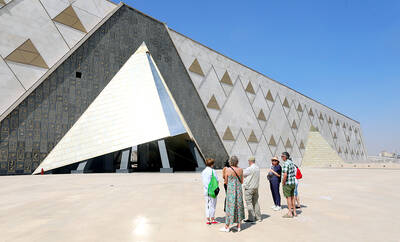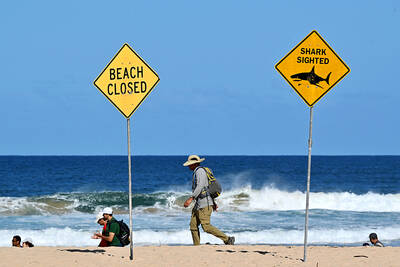At the children’s cancer hospital in Minsk, Belarus, and at the Vilne hospital for radiological protection in the east of Ukraine, specialist doctors are in no doubt they are seeing highly unusual rates of cancers, mutations and blood diseases linked to the Chernobyl nuclear accident 24 years ago.
But proving that infant mortality hundreds of kilometers from the stricken nuclear plant has increased 20 percent to 30 percent in 20 years, or that young people suffering from genetic disorders, internal organ deformities and thyroid cancers are the victims of the world’s greatest release of radioactivity, is impossible.
The WHO and the International Atomic Energy Agency (IAEA) claim that only 56 people have died as a direct result of the radiation released at Chernobyl and that about 4,000 will die from it eventually.
They also say that only a few children have died of cancers since the accident and, that most of the illnesses usually linked to Chernobyl are due to psychological distress, radiophobia or poverty and unhealthy living.
But other reputable scientists researching the most radiation-contaminated areas of Russia, Belarus and Ukraine are not convinced. The International Agency for Research on Cancer predicts 16,000 deaths from Chernobyl; an assessment by the Russian Academy of Sciences says there have been 60,000 deaths so far in Russia and an estimated 140,000 in Ukraine and Belarus.
Meanwhile, the Belarus National Academy of Sciences estimates 93,000 deaths so far and 270,000 cancers, and the Ukrainian national Commission for Radiation Protection calculates 500,000 deaths so far.
The mismatches in figures arise because there have been no comprehensive, coordinated studies of the health consequences of the accident.
There have been problems gathering reliable data from areas left in administrative chaos after the accident. Hundreds of thousands of people were moved away from the affected areas, and the break-up of the Soviet Union led to records being lost.
Controversy rages over the agendas of the IAEA, which has promoted civil nuclear power over the past 30 years, and the WHO. The UN accepts only peer-reviewed scientific studies written in certain journals in English, a rule said to exclude dozens of other studies.
Four years ago, an IAEA spokesman said he was confident the WHO figures were correct. And Michael Repacholi, director of the UN Chernobyl forum until 2006, has claimed that even 4,000 eventual deaths could be too high.
But Linda Walker, of the UK Chernobyl Children’s Project, which funds Belarus and Ukraine orphanages and holidays for affected children, called for a determined effort to learn about the effects of the disaster.
“Parents are giving birth to babies with disabilities or genetic disorders ... but, as far as we know, no research is being conducted,” she said.

With much pomp and circumstance, Cairo is today to inaugurate the long-awaited Grand Egyptian Museum (GEM), widely presented as the crowning jewel on authorities’ efforts to overhaul the country’s vital tourism industry. With a panoramic view of the Giza pyramids plateau, the museum houses thousands of artifacts spanning more than 5,000 years of Egyptian antiquity at a whopping cost of more than US$1 billion. More than two decades in the making, the ultra-modern museum anticipates 5 million visitors annually, with never-before-seen relics on display. In the run-up to the grand opening, Egyptian media and official statements have hailed the “historic moment,” describing the

SECRETIVE SECT: Tetsuya Yamagami was said to have held a grudge against the Unification Church for bankrupting his family after his mother donated about ¥100m The gunman accused of killing former Japanese prime minister Shinzo Abe yesterday pleaded guilty, three years after the assassination in broad daylight shocked the world. The slaying forced a reckoning in a nation with little experience of gun violence, and ignited scrutiny of alleged ties between prominent conservative lawmakers and a secretive sect, the Unification Church. “Everything is true,” Tetsuya Yamagami said at a court in the western city of Nara, admitting to murdering the nation’s longest-serving leader in July 2022. The 45-year-old was led into the room by four security officials. When the judge asked him to state his name, Yamagami, who

DEADLY PREDATORS: In New South Wales, smart drumlines — anchored buoys with baited hooks — send an alert when a shark bites, allowing the sharks to be tagged High above Sydney’s beaches, drones seek one of the world’s deadliest predators, scanning for the flick of a tail, the swish of a fin or a shadow slipping through the swell. Australia’s oceans are teeming with sharks, with great whites topping the list of species that might fatally chomp a human. Undeterred, Australians flock to the sea in huge numbers — with a survey last year showing that nearly two-thirds of the population made a total of 650 million coastal visits in a single year. Many beach lovers accept the risks. When a shark killed surfer Mercury Psillakis off a northern Sydney beach last

‘CHILD PORNOGRAPHY’: The doll on Shein’s Web site measure about 80cm in height, and it was holding a teddy bear in a photo published by a daily newspaper France’s anti-fraud unit on Saturday said it had reported Asian e-commerce giant Shein (希音) for selling what it described as “sex dolls with a childlike appearance.” The French Directorate General for Competition, Consumer Affairs and Fraud Control (DGCCRF) said in a statement that the “description and categorization” of the items on Shein’s Web site “make it difficult to doubt the child pornography nature of the content.” Shortly after the statement, Shein announced that the dolls in question had been withdrawn from its platform and that it had launched an internal inquiry. On its Web site, Le Parisien daily published a